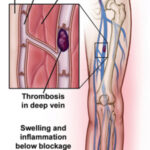Every year, over 50,000 people in America die of complications due to leg blood clots. These blood clots are known in medical terms as deep vein thrombosis, or DVT. A deep vein thrombosis develops in the veins of your lower legs. These clots will then travel up your veins, into your heart, and then into your lungs. Once in your lungs, they will jam into the small blood vessels. If the clot is large enough, this can lead to death. Because of this risk, it is important to be able to identify the symptoms associated with developing a leg blood clot.
The first and most obvious symptom associated with a leg blood clot is pain, tenderness, and swelling at the site of the clot in your leg. Oftentimes the skin over the clot will become red and warm to the touch. A person who is developing a leg blood clot will usually have pain or discomfort when they try to walk or put pressure on the leg. The soreness associated with a leg blood clot will often not resolve when a person attempts to rest. The pain and discomfort will be there regardless of your state of activity.
The most common location on the leg for the symptoms is the ankle, calf, or thigh. Typically, the swelling seen with a leg blood clot will extend the entire length of the leg below the site of a clot. In essence, this means that the upper edge of the swelling is often an approximate location of the clot. It is important to note that this is merely a guideline, and is not always the case.
On occasion, it is possible for a person with a leg blood clot to have no symptoms. This can happen when the blood clot is very small. Very small blood clots will cause no symptoms because they are not blocking a significant portion of the blood flow through the vein. Small blood clots can still be very dangerous if they are able to travel to your lungs. The vasculature in the lungs becomes quite small with even the smallest clots eventually getting stuck.
In most cases, a deep vein thrombosis will only be seen on one leg at a time. The presence of redness, swelling, pain, and tenderness on both legs at the same time is often an indicator that there may be some problem other than a deep vein thrombosis. Again this is a general rule and is not always the case. Certainly it is possible to develop a leg blood clot in both legs at the same time. Only your doctor can do the appropriate tests to determine the cause of your symptoms.
If you have questions about deep vein thrombosis and leg blood clots, be sure to speak with your doctor. Your doctor has a wide array of tests available to determine if your symptoms are related to a leg blood clot or some other medical problem. Leg blood clots which travel to the lungs and cause a pulmonary embolism are a medical emergency and must be treated immediately.


